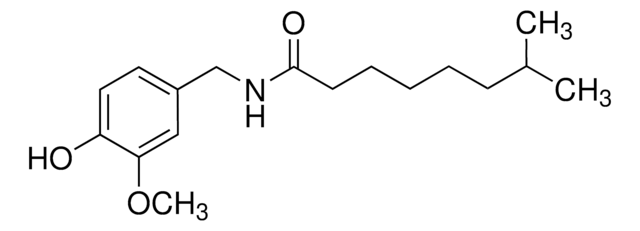12084
Capsaicin
analytical standard
Synonym(s):
8-Methyl-N-vanillyl-trans-6-nonenamide
About This Item
Recommended Products
grade
analytical standard
Quality Level
description
analytical standard for food analysis
Assay
≥98.5% (HPLC)
shelf life
limited shelf life, expiry date on the label
technique(s)
HPLC: suitable
gas chromatography (GC): suitable
mp
62-65 °C (lit.)
solubility
H2O: insoluble
application(s)
cleaning products
cosmetics
flavors and fragrances
food and beverages
forensics and toxicology
personal care
pharmaceutical (small molecule)
format
neat
storage temp.
2-8°C
SMILES string
COc1cc(CNC(=O)CCCC\C=C\C(C)C)ccc1O
InChI
1S/C18H27NO3/c1-14(2)8-6-4-5-7-9-18(21)19-13-15-10-11-16(20)17(12-15)22-3/h6,8,10-12,14,20H,4-5,7,9,13H2,1-3H3,(H,19,21)/b8-6+
InChI key
YKPUWZUDDOIDPM-SOFGYWHQSA-N
Gene Information
human ... TRPV1(7442)
Looking for similar products? Visit Product Comparison Guide
Application
- Determination of capsaicin in samples of chili pepper, black pepper powder, and chili pepper sauce by cyclic voltammetry using an office paper-based carbon black-screen printed electrode (CB-SPE)
- Development of an electrochemical sensor based on Ag/Ag2O-loaded poly(sodium-4-styrenesulfonate) (PSS) functionalized-reduced graphene oxide (rGO) composite (Ag/Ag2O-PSS-Rgo) to determine capsaicin in chili pepper samples
- Multi-residue analysis of six capsaicinoids in green bell pepper samples using an online supercritical fluid extraction combined with reverse phase-liquid chromatography-tandem mass spectrometry (RP-LC-MS/MS)
- Evaluation of an immunoaffinity chromatography (IAC) based cleanup using polyclonal antibodies (pAb) for the determination of capsaicin and dihydrocapsaicin in different types of vegetable oil samples by LC-MS/MS
- Thin layer chromatographic (TLC) separation and determination of capsaicin in ethanolic extracts of Capsicum annum Linn
Biochem/physiol Actions
Features and Benefits
Packaging
Other Notes
Signal Word
Danger
Hazard Statements
Precautionary Statements
Hazard Classifications
Acute Tox. 2 Oral - Eye Dam. 1 - Resp. Sens. 1 - Skin Irrit. 2 - Skin Sens. 1 - STOT SE 3
Target Organs
Respiratory system
Storage Class Code
6.1A - Combustible acute toxic Cat. 1 and 2 / very toxic hazardous materials
WGK
WGK 3
Flash Point(F)
235.4 °F - closed cup
Flash Point(C)
113 °C - closed cup
Personal Protective Equipment
Choose from one of the most recent versions:
Already Own This Product?
Find documentation for the products that you have recently purchased in the Document Library.
Customers Also Viewed
Our team of scientists has experience in all areas of research including Life Science, Material Science, Chemical Synthesis, Chromatography, Analytical and many others.
Contact Technical Service







